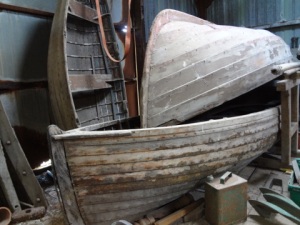The end of a blue and blowy day on Iona. I went down to the village to post letters thisafternoon and was reminded of how the North End is almost a seperate island. At Lagandorain: big skies, white flecked seas and a cold, searching wind, in the village: a douce quietness, a gentle breeze and a quiet and reflective Sound. More often than not I go to the village wearing woolly jumpers to discover folk in t-shirts… I’m always glad to turn north though, up beyond the Abbey – and once past the kink in the road at Achavaich I’ve got space and I know I’m home. Lagandorain is the only house on the island (I think) where you can see no other house lights. I love it.
On the subject of bicycles, Anna arrived last night (soaked) and left thismorning on her travels. I asked to take a picture of her and her bike. How could you not warm to someone cycling around the west of Scotland with a garland of red plastic roses festooned around her handlebars ?
The Black Boat is coming along and I’m slowly scraping the paint off her and revealing the condition of her timber. On the whole it’s good news but with a few startlingly big splits in planks. Some will need replaced but most will probably close when the wood is wet. To help the process, I’ll probably take her down to the harbour, put her on a mooring and sink her for a week or so. When she comes back out the wood will have swelled, ‘taking up’ it’s called, and I’ll have a far better idea of what needs replaced.
‘Black Boat’ she will no longer be. I’ve found traces of arsenic green under the black, which delights me as I love this colour. I can almost taste it. Which probably wouldn’t be so good as it was originally made with arsenic and this is the reason that a) a lot of colourmen (as the craftsmen who made paint were called) died young, and b) why they used to paint hospitals and toilets with it (to poison flies and bacteria, I presume…). It’s one of the colours that was readily available a hundred years ago and was ubiquitous: scratch any old house or boat or shed and you’ll probably find it. For me, it’s particulary evocative of croft-houses. It was a standard combination: arsenic green and a thick, gloopy cream (probably Farrow&Ball would call it ‘Heritage Parchment’). There was also a yucky dark brown colour ( in landscape painting it was called ‘Mummy’ -but more of that horrible tale later) and a strange lilac tone. No doubt there were more, but these are the ones that seemed to have been painted / distempered straight onto the plaster. To find them and to smell the old plaster is to flicker you back to a different epoch.
So anyway, household paint was used (nothing wasted!) on boats -and in return houses might be painted with grey tractor paint. While black might be correct for a Shetland skiff, arsenic is for me somehow richer, with a more human tale. So: arsenic upper strakes, a cream wave break and black anti-foul it’ll be.
One of the pleasures of unpacking boxes of books is to discover the bits and pieces tucked inside their covers. Having just made myself a ‘boat-case’ (a bookcase made from the stern section of a rowing-gig) I’ve been unpacking boxes that I haven’t opened since leaving Edinburgh in 2000. Yesterday I came across an article from my conservation days called ‘Body Colour: the Misuse of Mummy’. What a fabulous title ! It discusses a pigment used by artists until the early 20th century and manufactured from the embalmed bodies of ancient Egyptians -and you’re talking thousand of mummies. Basically Egypt’s funerary heritage (and dead) ground down into paint. Could you make this up ?! There was a strong trade in it for centuries and the gruesome details I’ll skip. Sally Woodcock, who wrote the article, summarises: ‘In addition to being of interest in the context of its use as a paint, the trade in mummy is also a paradigm of European colonialism, destroying Egypt’s archaeological heritage for commercial gain. Today, the technical imperfections of mummy as a pigment are far overshadowed by the arrogance and profligacy inherent in its manufacture…’
The article gives substance to the discussion of the return of artifacts to their place of origin (Elgin Marbles / Aboriginal bones and all that) -and in a much dilute but salutory way points to why, for our times, we should be supporting organisations such as ‘Tourism Concern’ (www.tourismconcern.org.uk), whose concern, broadly, is the respect for cultures, economies and traditions other than our own.
Just been told by a friend that she heard a corncrake on Iona in late April. So much for mine being the first…




